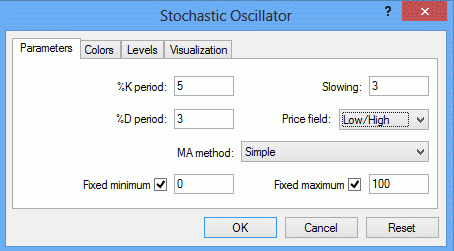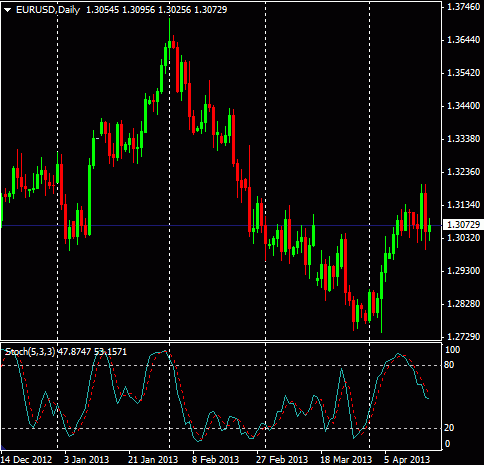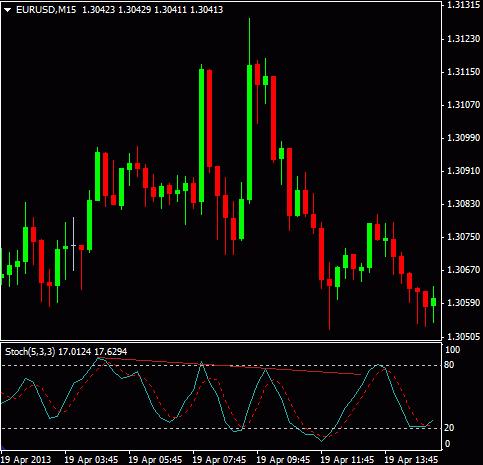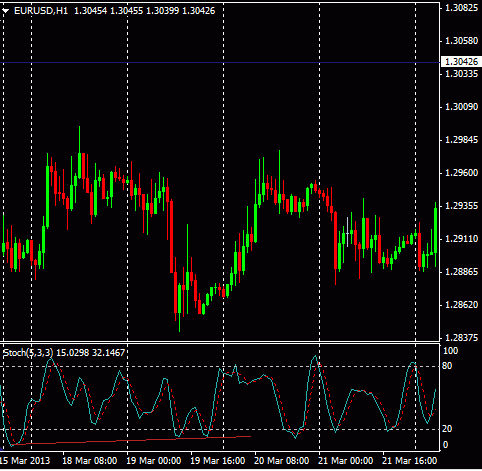Understanding the Stochastic Oscillator and Divergence
There are many technical indicators traders use, and among the most common is the Stochastic Oscillator. There are multiple trading methods involving this indictor, including using it to spot divergences. Spotting a divergence can alert to you potential trend reversals, and highlight underlying strength or weakness which may not be easily seen on the price chart. First, let’s take a look at what the Stochastic Oscillator is, and how it is composed, so when you trade with it you’ll know what it’s telling you. Then we’ll delve into divergence and how to use it. I’ll also touch on two other popular stochastic trading strategies, the overbought/oversold and the cross-over.
Stochastic Oscillator
Quite a mouthful, but the concept is quite simple. The indicator moves between 0 and 100 and reflects where an asset’s price is relative to a given time frame. If the indicator is near 0, the price is very near the low of the time frame you’re looking at. If the indicator is near 100, the price is very near the high price of the time you’re looking at.
This indicator is quite customizable, since it has three main variables you need to select, as well as some additional options depending on which charting platform you use.
Figure 1. Stochastic Oscillator – MetaTrader 4

The graphic above shows what you can expect (or something similar) when you add a Stochastic Oscillator to your chart. %K is the number of time periods you want to use in the calculation. If you use a 1 minute chart to trade, you may want to set this to 5 or 7, and therefore the indicator will be based on the last 5 or 7 minutes respectively. Above it has been set to 5.
“Slowing” allows you to smooth out the fluctuations of %K. Set it to 1 and your %K line on the indicator will jump back and forth rapidly. Set it to 3 and it will gyrate at a slower pace. Which you choose will depend on how active of a trader you are. Above it has been set to 3.
%D is a moving average of %K. This once again smooths out the %K line slightly. %D is usually shown as a dotted line, which tracks the %K line on the indicator. In the graphic above, 3 has been selected for this variable. Therefore, %D will be a 3 period moving average of %K.
The Price Field allow you to select which prices will be used in the stochastic calculation. In the example above the High/Low has been chosen to capture all the price data in the bar. Alternatively, you can choose to use the closing price.
The final option is to choose which type of moving average (MA) you’ll use. Using a simple moving average is the most common method, but you can also choose between exponential, smoothed or weighted moving averages. The different averages respond in your own way to price movements, and therefore, some knowledge of moving averages will help in determining which to use. Stick with the Simple MA if you are unsure which to use.
Figure 2 shows a EUR/USD Stochastic based on the selected criteria above.
Figure 2. EUR/USD with Stochastic

Source: Oanda – MetaTrader
Divergence
Now that the stochastic is set up, you can start to look for divergence. A divergence occurs when the indicator doesn’t move in-line with price. For example, the price makes a new high, but the stochastic fails to reach a new high. Or, price makes a new low, but the stochastic fails to make a new low. The former is a case of bearish divergence, because it signals potential weakness, and the latter is a case of a bullish divergence because it indicates potential strength.
When a divergence occurs, it should put you on guard for a potential change in price direction. Although, divergence is not a timing indicator; it may take some time for a reversal to occur following a divergence. Therefore, don’t trade just on divergence.
When you have a bearish divergence, wait for the price to break lower before going short/buying puts. Figure 3 shows the price making new highs, but the stochastic is not–a bearish divergence indicating a reversal could be coming soon, and it does.
Figure 3. Bearish Divergence Example

Source: Oanda – MetaTrader
When you have a bullish divergence, wait for the price to break higher before buying/buying calls. In figure 4 below the price continues to make lower lows, but the stochastic does not. This is a bullish divergence indicating a reversal higher could be forthcoming, and the EUR/USD did bounce.
Figure 4. Bullish Divergence Example

Source: Oanda – MetaTrader
Brokers with Stochastic and Technical Analysis Tools:
Stochastic Overbought/Oversold
Divergence is a not a timing indicator, but this strategy is. Therefore, this strategy can be used in conjunction with divergence, or on its own.
Another common strategy for the stochastic is to look for overbought or oversold conditions. Above 80 is considered overbought, while below 20 is oversold.
Buy (calls) when the price drops below 20 and then rises back above it (not before!).
Sell (buy puts) when the price rises above 80 and then drops back below it (not before!).
Ideally look to buy (calls) using the oversold (below 20) strategy when the overall price trend is up. This will allow you to enter following a pullback but as the price is starting to rise again.
Look to sell (buy puts) using the overbought (above 80) strategy when the overall price trend is down. This will allow you to enter following a pullback but as the price is starting to fall again.
Refer to charts above to spot potential trades.
Stochastic Cross-Overs
A final strategy for the stochastic is to trade cross-overs. This strategy can be used in conjunction with divergence, or on its own.
Buy when the %K line rises above %D (usually the dotted line). Sell (buy puts) when the %K line falls below the %D line.
Refer to charts above to spot potential trades.
Final Word
The stochastic has three main strategies, and can be used in conjunction with one another, or on their own. When using just divergence, you’ll need an additional method to signal when you will enter a trade. Divergence can last a long time, therefore, wait for the price to confirm the price reaction you are looking for. With multiple variables, the stochastic is very customizable. Tinker with different settings to get a feel for how it acts, and to find variables that work for the time frame and strategies you’re employing.